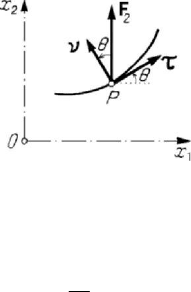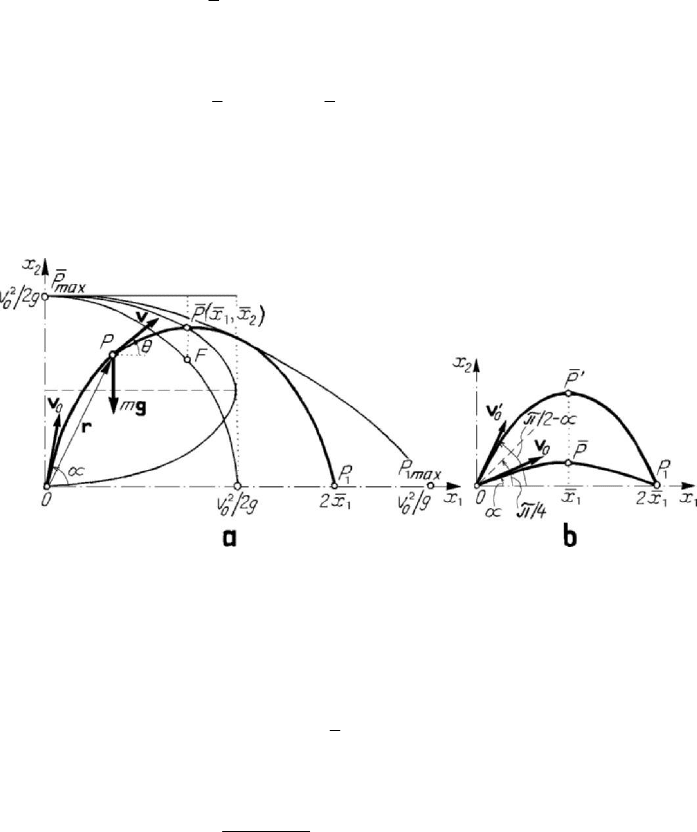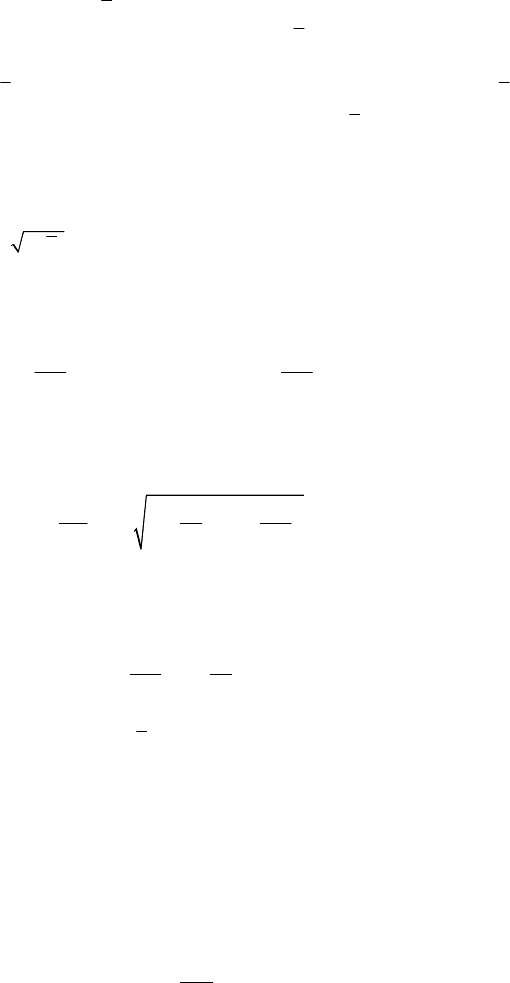Teodorescu P.P. Mechanical Systems, Classical Models Volume I: Particle Mechanics
Подождите немного. Документ загружается.

Chapter 7
PROBLEMS OF DYNAMICS OF THE PARTICLE
One of the most important cause (input) which leads to the motion of a mechanical
system is the gravitational field, in particular the terrestrial one; some results concerning
the motion of a free particle in vacuum or in a resistent medium are also given, and
some considerations concerning the pendulary motion of a particle subjected to
constraints are made. Other important classical problems of dynamics of the particle are
then presented and notions on the stability of its equilibrium are given.
1. Motion of the particle in a gravitational field
First of all, we deal with some particular cases of motion of a free particle, i.e., the
rectilinear and the plane motion, as well as the motion of a heavy particle; another case
of motion of a particle subjected to constraints, that is the plane and the three-
dimensional pendulary motion, is then studied.
1.1 Rectilinear and plane motion
Of a particular interest in the study of the three-dimensional motion of a free or
constraint particle is the motion of its projection on a fixed straight line or plane; we are
thus led to consider some particular cases of rectilinear and plane motions of a particle.
1.1.1 Rectilinear motion of a particle
We choose as rectilinear trajectory of a free particle
P a straight line parallel to the
1
Ox -axis, of equations
0
22
constxx== ,
0
33
constxx== ; the equations (6.1.22')
show that the resultant
F of the given forces must verify the conditions
23
0FF==,
hence it must have a fixed direction (the same as that of the
1
Ox -axis); but the latter
conditions are not sufficient to obtain the mentioned trajectory. Indeed, the above
conditions lead to
23
0xx== , hence to
()
00
0
kk k
xxtt x
=
−+ , corresponding to the
initial conditions
()
0
0
kk
xt x= ,
()
0
0
kk
xt x=, 2, 3k
=
; to obtain the searched
trajectory, one must have
00
23
0xx
=
= too and we may state
Theorem 7.1.1. The trajectory of a free particle is rectilinear if and only if the resultant
of the given forces acting upon it has a fixed direction and its initial velocity has the
same direction.
401

MECHANICAL SYSTEMS, CLASSICAL MODELS
402
In this case, the support of the force
F coincides with the rectilinear trajectory,
while ther equation of motion is reduced to (
0
22
xx= ,
0
33
xx= )
mx F
=
, (7.1.1)
where
()xxt
=
, (,;)FFxxt= and where, for the sake of simplicity, we have
omitted the index 1; the initial conditions are of the form
(
)
00
xt x
=
,
(
)
00
vt v
=
.
(7.1.1')
If the resultant of the given forces depends only on time (
()FFt
=
), then – by
successive integrations – we get
0
0
() () ( )d
t
t
mv t mx t mv F ττ==+
∫
,
(7.1.2)
()
00
000
() d ( )d
t
tt
mx t mx mv t t F
τ
τττ=+ −+
∫∫
.
(7.1.2')
In particular, if
0
constFma== , we obtain
(
)
00 0
()vt v a t t
=
+−,
()()
2
0
00 0 0
()
2
a
xt x vtt tt=+ − + −
.
(7.1.3)
Assuming that
()FFx= (the resultant of the given forces depends only on the
position), we may use the results obtained in Chap. 6, Subsec. 2.2.1 concerning the
dynamics of a particle constrained to move on a given fixed curve; the formula (6.2.18')
allows to write
0
0
d
()
x
x
tt
ξ
ϕξ
−=±
∫
,
0
2
2
() ()d
x
x
xv F
m
ϕξξ=+
∫
,
()
2
00
0xvϕ
=
≥ .
(7.1.4)
We notice that the sign in the above formula corresponds to the sign of the initial
velocity
0
v . If
0
0v =
, then
(
)
0
0xϕ
=
and we must take the sign for which
() 0xϕ ≥ . If ()xϕ is a monotone increasing or decreasing function, then the sign + or
–, respectively, is taken; noting that
() (2/ ) ()xmFxϕ
′
=
, it results that, in the case of
a vanishing initial velocity, the particle moves on the trajectory, departing from the
initial position, in the same direction as that of the force. In the above considerations,
we assumed tacitly that, if
0
0v
=
, then () 0xϕ
′
≠
, because
(
)
0
0Fx
≠
; hence,
0
x is
only a simple zero for
()xϕ .
Let
1
x and
2
x be two consecutive simple zeros of ()xϕ , so that
0
12
xxx<<; in
this case
(
)
(
)
12
() ()xxxxxxϕψ=− − , () 0xψ > ,
[
]
12
,xxx
∈
.
(7.1.5)

Problems of dynamics of the particle
403
The particle
()Px departs from the point
00
()PPx
≡
with the velocity
0
0v ≠ (let
be
0
0v > ) and oscillates between the positions
11
()PPx
≡
and
22
()PPx≡
(Fig.7.1); assuming that the particle reaches the position
2
P at the moment t
′
with the
velocity
(0)0vt
′
−>, then the position
1
P at the moment t
′
′
with the velocity
(0)0vt
′′
−<, and returns to
0
P at the moment t
′
′′
with the velocity (0)0vt
′′′
−>,
we obtain
()()
2
0
0
12
d
()
x
x
x
tt
xx x x x
ϕ
′
−=
−−
∫
,
()()
1
2
12
d
()
x
x
x
tt
xx x x x
ψ
′′ ′
−=−
−−
∫
,
()()
0
1
12
d
()
x
x
x
tt
xx x x xψ
′′′ ′′
−=
−−
∫
,
so that
0
/2ttt tttT
′′ ′ ′′′ ′′ ′
−
=−+−= . After an interval of time
()()
2
1
12
d
2
()
x
x
x
T
xx x x xψ
=
−−
∫
,
(7.1.5')
called the period of the motion, the particle returns to the same position
0
P with the
same velocity; because the position
0
P is arbitrary, while T does not depend on this
position, it follows that the motion is periodic. In this case, the function
()xxt= given
by the relation (7.1.4) is a periodic function.
Figure 7.1. Rectilinear motion of a particle.
If the resultant of the given forces depends only on the velocity (
()FFv= ), then
we use the equation of motion written in the form (1.1.89''), obtaining thus
0
0
d
()
v
v
m
tt
F
η
η
−=
∫
;
(7.1.6)
hence, if it is possible, we calculate
(
)
0
vx ttχ
=
=− , wherefrom
()
0
00
d
t
t
xx tχτ τ−= −
∫
,
(7.1.6')
the initial conditions (which imply two constants of integration) being also verified, so
that the problem is solved. If the function
χ cannot be determined, then we may write
0
0
d
()
v
v
m
xx
F
ηη
η
−=
∫
,
(7.1.7)

MECHANICAL SYSTEMS, CLASSICAL MODELS
404
being thus led to the parametric representation
()xxv
=
, ()ttv
=
, where v is the
hodographic variable; thus, for any
v with () 0Fv
≠
, we may associate to the
moment
t a position x of the particle (the velocity of the particle at that moment is
v ). Assuming that from the relation (7.1.7) we obtain the function
(
)
0
vx xx== −
, it results
()
0
0
0
d
x
x
tt
x
ξ
ξ
−=
−
∫
,
(7.1.7')
so that we may determine
00
(; , )xxttx
=
.
If the force
F depends on two or three of the variables ,,xvt, the problem becomes
more intricate, and may be solved from case to case.
If
(
)
00
;,xftxv= is given, one can enunciate the inverse problem: to determine the
force
F which leads to such a motion. We obtain thus
()
00
;,vftxv=
and
()
00
;,aftxv=
; eliminating the constants
0
x and
0
v , we find the solution of the
problem
()
00
; (;,), (;,) (;,)F mf tx txv v txv Ftxv==
, which is univocally
determinate. If only a particular motion
()xft
=
, which leads to ()vft=
, ()aft=
,
is known, then the solution of the problem is indeterminate; it becomes determinate if
we introduce supplementary conditions, e.g., imposing that the force
F
do depend only
on one of the variables
t
, x or v .
1.1.2 Plane motion of a particle
Let us suppose that the trajectory of a particle
P is contained in the fixed plane
0
33
constxx== , parallel to the plane of co-ordinates
12
Ox x ; in this case, the
resultant of the given forces
F must verify the condition
3
0F
=
, hence it must be
parallel to the same fixed plane (it must be normal to a fixed direction, the same as that
of the
3
Ox -axis). But the latter condition is not sufficient to obtain the mentioned
trajectory; indeed, the condition
3
0F
=
leads to
3
0x
=
, wherefrom
()
00
0
33 3
xxtt x=−+ , corresponding to the initial conditions
()
0
0
33
xt x= ,
()
0
0
33
xt x=
. To can obtain the trajectory mentioned above, we must have
0
3
0x =
and may state
Theorem 7.1.2. The trajectory of a free particle is a plane curve if and only if the
resultant of the given forces acting upon it is parallel to a fixed plane (is normal to a
fixed direction) and its initial velocity has the same property.
Obviously, the plane which contains the trajectory (which contains the force
F
and
the initial velocity
0
v too) passes through the initial position of the particle, and the
equations of motion are reduced to (
0
33
xx=
)
(
)
1212
,,,;mx F x x x x t
αα
= , 1, 2α
=
;
(7.1.8)

Problems of dynamics of the particle
405
the initial conditions are of the form (
()xxt
αα
=
)
()
0
0
xt x
αα
= ,
()
0
0
xt x
αα
=, 1, 2α
=
.
(7.1.8')
If the functions
F
α
fulfil certain conditions, the integration of the system of
equations (7.1.8) may become easier. Such a case is that in which the motions of the
particles associated to the projections of the particle
P on the two axes in the plane
may be studied independently, being governed by equations of the form
(
)
1111
,;mx F x x t= ,
(
)
2222
,;mx F x x t
=
.
(7.1.9)
A particular case of a given force parallel to a fixed plane is the force of constant
direction; the trajectory of the particle is thus in the plane determined by the initial
velocity and by the direction of the force. Let us suppose that this plane is parallel to the
12
Ox x -plane (
0
33
constxx== ). The equation of motion can be written in the form
1
0mx = ,
22
mx F= , wherefrom
()
00
0
11 1
xvtt x=−+;
(7.1.10)
in this case, one can eliminate
1
x and
1
x from
(
)
2 2 1212
,,,;FFxxxxt
=
, so that the
second equation of motion will be given by
(
)
2222
,;mx F x x t
=
.
(7.1.10')
Figure 7.2. Plane motion of a particle.
The equations in intrinsic co-ordinates (6.2.19) are of the form (Fig.7.2)
2
sinmv F θ=
,
2
2
cos
v
mF
θ
ρ
= ,
(7.1.11)
where
ρ is the curvature radius of the trajectory; we notice also that
0
1
cosvvθ = .
(7.1.11')
Eliminating the velocity
v we get
()
2
30
21
cos constFmvρθ==;
(7.1.12)

MECHANICAL SYSTEMS, CLASSICAL MODELS
406
in the particular case in which
2
constF
=
, it results
3
cos constρθ= ,
(7.1.12')
hence the intrinsic equation of a parabola.
Assuming that the functions
(
)
0000
1212
;,,,xftxxvv
αα
= are given, one may
enunciate the inverse problem: to determine the force
F of components F
α
,
1, 2α =
,
which leads to this motion. We can calculate
(
)
0000
1212
;,,,vftxxvv
αα
=
,
(
)
0000
1212
;,,,aftxxvv
αα
=
; eliminating the constants of integration
0000
1212
,,,xxvv, we
find the solution
(
)
1212
;,,,FFtxxvv
αα
= , 1, 2α
=
, of the problem, which is
univocally determinate. As in the previous subsection, if only one particular motion is
known, then the solution of the problem is indeterminate; one must introduce
supplementary conditions to obtain a determinate solution.
For instance, assuming that the trajectory of the particle is expressed in the form
(
)
21
xfx= , the force F which acts upon this particle being parallel to the
2
Ox -axis,
we may write
()
() ( ) ()
[]
2
0
211 121221
,,,;F mv f x Gxxxxt x fx
′′
=+ − ,
(7.1.13)
where
G is an arbitrary function of class
0
C (as in Chap. 6, Subsec. 1.1.4); the
indetermination of the solution of the second basic problem is thus obvious.
More general, we may consider the motion of a particle
P the projection of which
(we assume that to each projection we associate a particle of the same mass as the
particle
P , but – for the sake of simplicity – we mention it no more) on a plane and on
an axis non-parallel to that one or on three non-coplanar axes may be studied
independently (as plane or rectilinear motions, respectively).
1.2 Motion of a heavy particle
In what follows, we consider first of all the general motion of a heavy particle in
vacuum or in a resistent medium; the results thus obtained will be then particularized
for the case of a rectilinear trajectory. Analogously, we present the study of the motion
of a heavy particle constrained to stay on a curve or on a plane.
1.2.1 Motion of a heavy particle in vacuum
In the preceding subsection we have considered the motion of a particle acted upon
by a force of constant direction. In particular, it is interesting to assume that the
magnitude of the force is constant in time too; we will thus study the motion of a heavy
particle
P (the motion of a particle in the gravitational field of the Earth), of mass m ,
in vacuum. The equation of motion reads
=
rg, where g is the gravity acceleration,
so that
() ()
2
0000
1
2
tt tt
=
−+ −+rg v r,
(
)
00
tt
=
−+vg v,
(7.1.14)

Problems of dynamics of the particle
407
where we took into account the initial conditions
(
)
00
t
=
rr,
(
)
00
t
=
vv;
(7.1.14')
these results correspond to the formulae (5.1.35), which specify the motion of a particle
of constant acceleration. As we know, the trajectory is a plane curve; indeed, the vector
0
−rr is a linear combination of the constant vectors g and
0
v . Without any loss of
generality, we may suppose that
0
0t
=
,
0
=
r0, so that
2
0
1
2
tt=+rgv
,
0
t
=
+vg v;
(7.1.14'')
hence, we obtain the remarkable relations
()
2
0
11
22
tt t=− + = +rgv vv
.
(7.1.14''')
We assume that
0
≠v0 and that it has not the same support as g ; in this case, the
velocity
v
cannot vanish, while the second relation (7.1.14''') allows to determine the
velocity of the particle
P by a simple drawing if its position is known or allows to
determine graphically its position if its velocity is known.
Figure 7.3. Motion of a heavy particle in vacuum: Cauchy problem (a); bilocal problem (b).
Projecting the equations (7.1.14'') on two orthogonal axes in the plane
12
Ox x (we
take
2
g=−gi,
(
)
00
12
cos sinv αα=+vii, /2 /2παπ
−
<< ), we obtain the
parametric equations of the trajectory (Fig.7.3,a)
0
1
cosxvtα= ,
2
0
2
1
sin
2
xgtvtα=− +
,
(7.1.15)
wherefrom, eliminating the time
t , we may write
2
211
22
0
tan
2cos
g
xxx
v
α
α
=− +
;
(7.1.15')

MECHANICAL SYSTEMS, CLASSICAL MODELS
408
hence, the trajectory of the particle
P is a parabola, as it was shown in Subsec. 1.1.2
and in Chap. 5, Subsec. 1.3.1. The velocity of the particle at a given moment is given by
0
1
cosvv α= ,
0
2
sinvgtvα
=
−+
, (7.1.16)
so that
2
00
2
cos
2
cos
vv gxv
α
θ
=− =
,
(7.1.16')
where we took into account the formula (7.1.11') too. Choosing the angle
θ as
generalized co-ordinate, taking into account (7.1.15), (7.1.16') and eliminating the time
t , we may write
()
22
0
0
1
cos
tan tan
v
x
g
α
θθ
=− − ,
()
22
0
22
2
cos
sec sec
v
x
g
α
θα
=− − .
(7.1.15'')
The potential of the conservative force
mg is
2
Umgx
=
− , so that we may write the
conservation theorem of mechanical energy in the form
2
2
2
v
mmgxh=− +
,
consth
=
;
(7.1.15''')
we find thus again the expression (7.1.16') of the magnitude of the velocity.
If
0α > , then we obtain the basic problem of ballistics in the case in which the
friction with the air is neglected. The particle (eventually, a projectile) reaches the
highest point
P of the trajectory for
2
0v
=
, hence at the moment
()
0
0
2
/sin /tvg vgα==; the co-ordinates of this point are
000
212
2
1
sin
2
vvv
x
gg
α==,
()
2
0
2
2
0
2
2
sin
22
v
v
x
gg
α
==,
and we find again Torricelli’s formula (5.1.37) in the form
0
2
2vgh= ,
2
hx
=
.
(7.1.17)
We obtain thus the component
0
2
v of the velocity by which we may launch the
projectile to reach the height
h ; because the angle α is not involved in the formula,
one states that it remains valid for the motion on a vertical line (
/2απ
=
) too. The
formula (7.1.16') may be written also in the form
(
)
22
0
2
2/2vgvgx=−; we may thus
state that the magnitude of the velocity at a given moment is equal to that of a falling
particle, without initial velocity, from the height
2
0
/2vg.

Problems of dynamics of the particle
409
If
0α < , then the particle departs from a point on the decreasing branch of the
parabola.
The point
1
P of abscissa
(
)
2
0
1
2/sin2xvg α= is the most distant point reached by
the projectile on a horizontal plane, at the moment
2t , the magnitude of the velocity
being the same as that at the initial moment; the range of the throw is maximal for
/4απ= , i.e.,
2
0
1max
2/xvg=
. If we wish to reach a point
1
P of abscissa
1
2x , then
the initial conditions must verify the relation
2
0
1
sin 2 2vgxα = (a bilocal problem). To
the same magnitude
0
v of the initial velocity there correspond two angles: /4απ<
and
/2πα
−
(symmetric with respect to the angle /4π , because /4πα−
(
)
/2 /4παπ=−−) under which one may reach the same point
1
P (Fig.7.3,b); in
particular, if
0
1
2vgx= , then we have /4απ
=
. To the two shooting angles there
correspond the shooting heights
(
)
22
0
/2 sinhvg α=
and
(
)
22
0
/2 coshvg α=
.
The projectile passes through the point
(
)
12
,P ξξ if the condition
22
11
2
12
22
00
tan tan 0
22
gg
vv
ξξ
αξ αξ
−
++ =
is fulfilled; as in the particular case considered above, one may reach the point
P
shooting a projectile under two angles specified by
2
2
01
2
22
1
00
2
tan 1 1
2
g
v
g
g
vv
ξ
αξ
ξ
⎡
⎤
⎛⎞
=±− +
⎢
⎥
⎜⎟
⎝⎠
⎣
⎦
.
(7.1.18)
To reach a point
P by a projectile, that one must be in the interior of the safety
parabola (Fig.7.3,a)
2
0
2
21
2
0
2
2
v
g
xx
g
v
=− +
,
(7.1.18')
which passes through the points
(
)
2
max
0
0, / 2Pvg and
(
)
2
0
1max
/,0Pvg; no point in
the exterior of this parabola may be reached by an initial velocity of magnitude
0
v .
This parabola is the envelope of the family of trajectories (7.1.15') for
0
constv = and
α variable.
The semilatus rectum of the parabola (7.1.15') is
(
)
22
0
/cospvg α= , so that the
locus of the focus
(
)
(
)
(
)
22
00
/2 sin2 , /2 cos2Fv g v gαα−
is the quarter of circle
(Fig.7.3,a)
4
0
22
12
2
4
v
xx
g
+=
,
(7.1.19)

MECHANICAL SYSTEMS, CLASSICAL MODELS
410
the centre of which is the origin and which passes through the point
max
P
; all these
parabolas have as directrix a parallel to the
1
Ox -axis of equation
2
0
2
/2xvg=
, which
passes through the vertex of the safety parabola. The locus of the vertices of the
trajectories (7.1.15') is the ellipse (Fig.7.3,a)
2
0
22
12 2
2
4
v
xx x
g
+=
,
(7.1.20)
the minor axis of which is
max
OP , the major axis being parallel to the
1
Ox -axis (the
half of it is equal to
2
0
/2vg).
1.2.2 Motion of a heavy particle in a resistent medium
In the case of a particle
P
which is moving in a resistent medium, besides the given
force (eventually, the gravity force) intervenes also a force
R
, called resistance,
corresponding to the resistance of the medium; under the action of the forces
F
and
R
, the particle moves as a free one. As a matter of fact, the force
R
is the resultant of
superficial actions (pressure and friction) on the body, which may be modelled as a
particle. Such a body is, for instance, a projectile in motion, which has a spherical form
and is not subjected to rotations; from the point of view of the mathematical modelling,
the projectile is reduced to its centre of gravity. The resistent medium may be the air,
the influence of which cannot be – in general – neglected; the respective problems form
the so-called external ballistics. It is assumed that the force
R
has the same support as
the velocity
v , but is of opposite direction. The magnitude of this force depends –
especially – on the magnitude
v of the velocity; one may conceive also a dependence
on the density or on the pressure of the air, on the absolute temperature, on the form of
the projectile etc. (e.g., after Langevin,
(
)
/Rapfv T= , consta
=
, where p is the
pressure of the air, while
T
is the absolute temperature). We will suppose that
()versmg vϕ=−Rv, (0) 0ϕ
=
, lim ( )
v
vϕ
→∞
=
∞ ,
(7.1.21)
where
()vϕ is a strictly increasing function (the resistance of the air increases together
with the velocity
v ); there exists – obviously – a value v
∗
and only one for which
() 1vϕ
∗
= .
Returning to the demonstration in Subsec. 1.1.1, we notice that the trajectory of the
particle is rectilinear, e.g., parallel to the
1
Ox -axis, of equations
0
22
constxx== ,
0
33
constxx== , if
23
0FF==, as it results from the equations
()
ii i
mx F mg v xϕ=− , 1, 2, 3i
=
, () ()/vvvϕϕ
=
.
But these conditions imposed to the force
F lead to () 0
kk
mx g v xϕ
+
= , wherefrom
0
(( ))d
0
e
t
t
gv
kk
xx
ϕττ−
∫
=
, 2, 3k
=
;
